If you want to learn more about 14×16 outdoor pavilion plans you have to take a close look over the free plans in the article. This large pavilion has a gable roof with a 30 degree slope, so you can build it even in areas with significant precipitations. This pavilion is built on a 6×6 base frame, so it will be very sturdy and durable. Remember to read the local codes before starting the project and to comply with the local regulations. The codes differ from one area to another, so it is safer to read them thoroughly.
If you want to get the job done in a professional manner, we recommend you to plan everything with attention, as to prevent costly mistakes and to build a professional garden project. Invest in high quality materials, such as cedar, pine or redwood, as the bench will be exposed to all kinds of weather. Apply a few coats of paint over the components, to enhance their appearance and to protect them from bad weather. In addition, I have these plans in an easy printable format for you, so you can download them.
14×16 Outdoor Pavilion Plans – Free Online – PDF Download
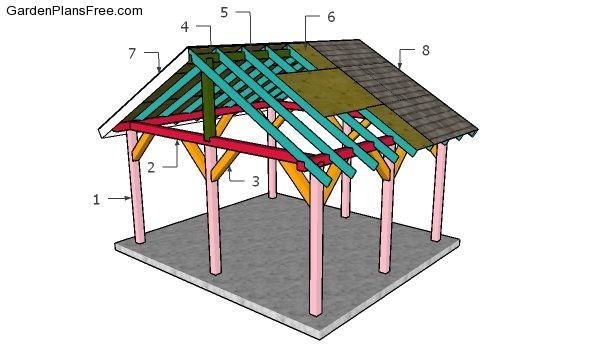
How to build a 14×16 pavilion
Materials
- 1 – 8 pieces of 6×6 lumber – 96″ long POSTS
- 2 – 4 pieces of 6×6 lumber – 192″ long SUPPORT BEAMS
- 3 – 16 pieces of 6×6 lumber – 36″ long BRACES
- 4 – 2 pieces of 6×6 lumber – 54 1/2″ long, 1 piece – 192″ long, RIDGE BEAM
- 5 – 18 pieces of 2×6 lumber – 192″ long RAFTERS
- 6 – 6 pieces of 3/4″ plywood – 48″x96″ long, 4 pieces – 48″x48″ long, 4 pieces – 36″x96″ long ROOF
- 7 – 4 pieces of 1×8 lumber – 133 1/4″ long, 2 pieces – 192″ long TRIMS
- 8 – 380 sq ft of tar paper, 380 sq ft of asphalt shingles ROOFING
- 9 pieces of 6×6 lumber – 8′
- 5 pieces of 6×6 lumber – 16′
- 4 pieces of 6×6 lumber – 12′
- 1 piece of 6×6 lumber – 10′
- 18 pieces of 2×6 lumber – 12′
- 10 pieces of 3/4″ plywood – 4’x8′
- 2 pieces of 1×8 lumber – 16′
- 4 pieces of 1×8 lumber – 12′
- 380 sq ft of tar paper, 380 sq ft of asphalt shingles
- 8 post anchors
- 500 pieces 1 5/8″ screws
- 76 pieces 5 1/2″ screws
- 8″ screws
- wood glue, stain/paint
- rafter ties
- 1 1/2 structural screws
- 100 pieces 2 1/2″ screws
- 1000 pieces staples
Tools
- Hammer, Tape measure, Carpentry square
- Miter saw, Drill machinery, Screwdriver, Sander, Router
- Safety Gloves, Safety Glasses, Respiratory Mask
Time
- One week
14×16 Outdoor Pavilion – Video
STEP 1: Building the base of the pavilion
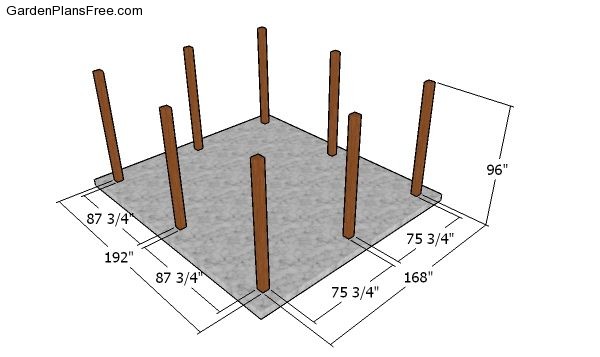
Laying out the posts
The first step of the garden project is to select the location for the pavilion. Make sure the ground is level and then layout the 6×6 posts with batter boards and string. Measure the diagonals and apply the 3-4-5 rule to the corners, to make sure the corners are square.
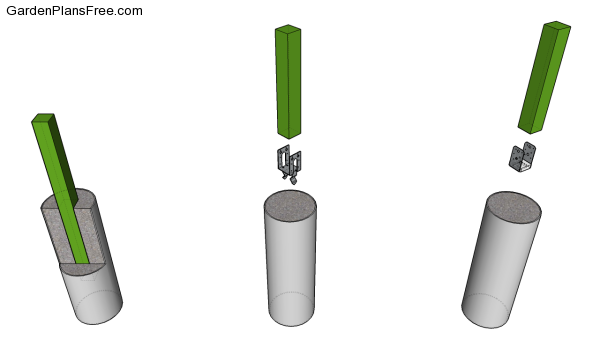
Fitting the posts into concrete
You can set the posts into place with several methods. First of all, you can attach the posts to an already existing concrete slats using metal anchors. Alternatively, you can dig 2-3′ deep holes and pour concrete footing in which you set post anchors. Last but not least, you can dig the holes and set the posts directly into concrete.
For this project, we will assume you will use metal anchors. Use a spirit level to plumb the posts vertically and use temporarily braces to lock them, until you build the roof for the pergola.
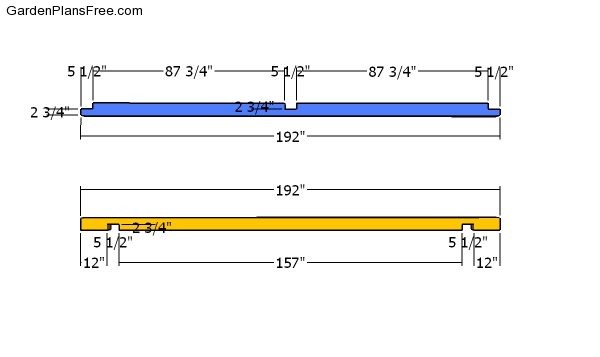
Building the plates
Use 6×6 lumber for the top plates. Mark the cut lines on the beams and then make the notches with a circular saw. Make parallel cuts and then clean the recess with a chisel.
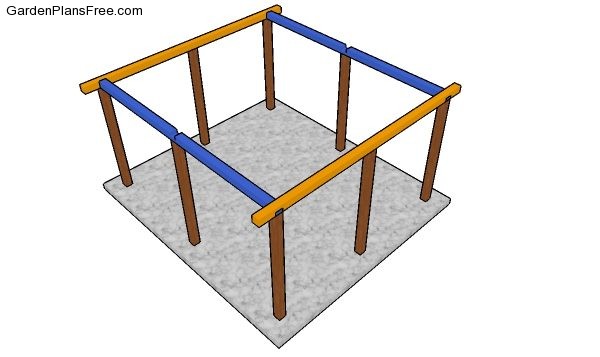
Fitting the top plates
Attach the beams to the top of the posts, as shown in the diagram. Make sure the corners are square and align the edges with attention. Drill pilot holes through the plates and insert 8″ screws into the posts.
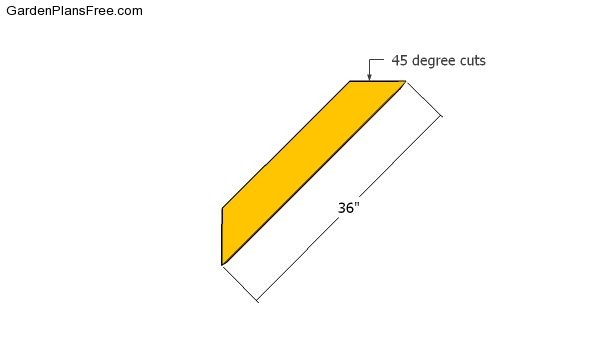
Building the braces
Use 6×6 lumber for the braces. Use a miter or circular saw to make the 45 degree cuts at both ends.
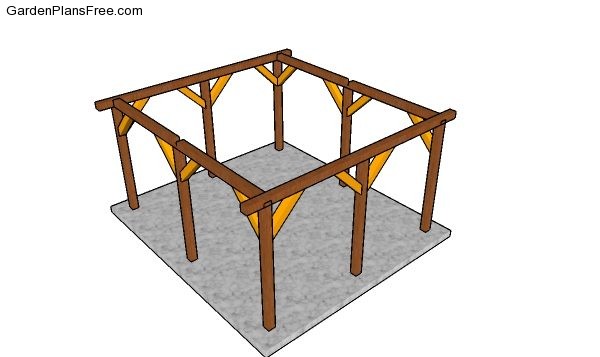
Fitting the braces
Use 6×6 lumber for the braces. Use a miter saw or a circular saw to make the 45 degree cuts at both ends of the braces. Fit the braces to the frame of the pavilion after you plumb the posts perfectly. Drill pilot holes through the braces and insert 5 1/2″ screws to lock them into place tightly. 2 screws for each joint.
STEP 2: Building the roof of the pavilion
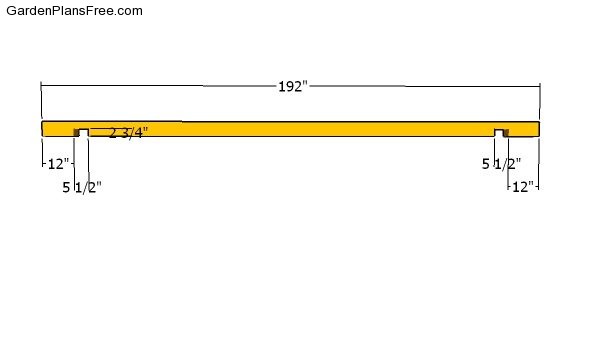
Building the ridge beam
Next, build the ridge beam from 6×6 lumber. Mark the cut lines on the beams and then get the job done with a circular saw. Clean the recessed with a chisel.
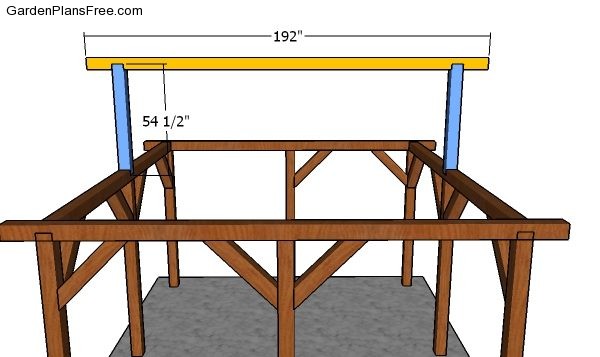
Fitting the ridge beam
Fit the 6×6 supports to the top plates and plumb them with a spirit level. Attach the ridge beam to the top of the supports and secure them into place with 5 1/2″ screws. Make sure the corners are square.
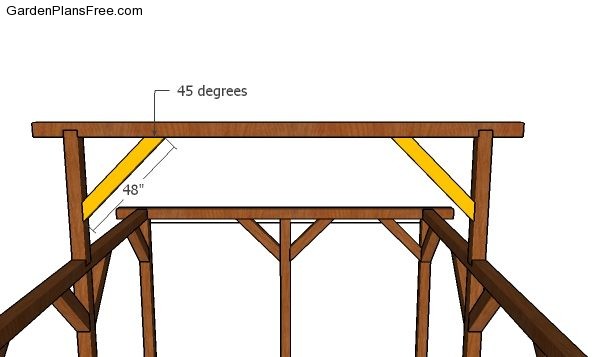
Ridge beam braces
Use 6×6 lumber for the top braces. Make 45 degree cuts at both ends of the braces and then secure them in place with 5 1/2″ screws.
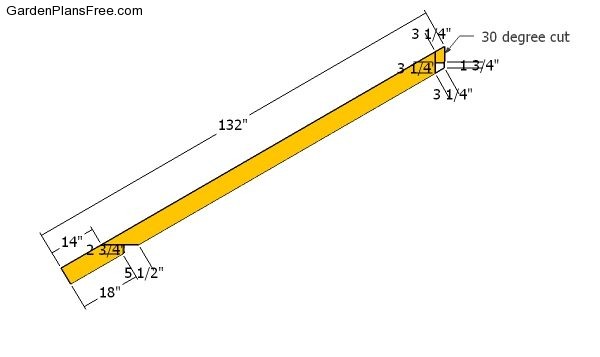
Building the rafters
Use 2×6 lumber for the rafters. Use a miter saw to make a 30 degree cut to one end of the rafters. Mark the cut lines on the rafters and then make the cuts with a circular saw.
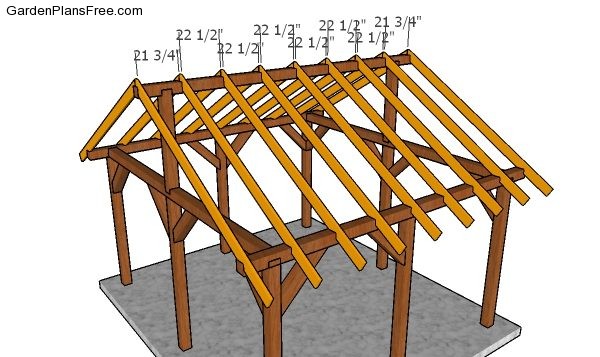
Fitting the rafters
Fit the rafters to the top of the pavilion, every 24″ on center. Align the edges at both ends and lock them to the plates with rafter ties.
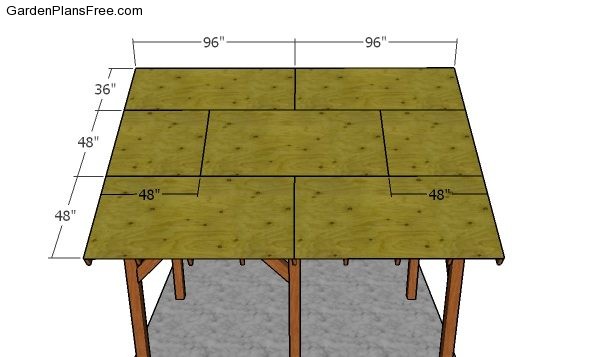
Roof sheets
Attach the 3/4″ plywood sheets to the roof of the pavilion. Start with the bottom and then attach the sheets up to the top. Leave no gaps between the sheets and insert 1 5/8″ screws. every 8″ along the framing.
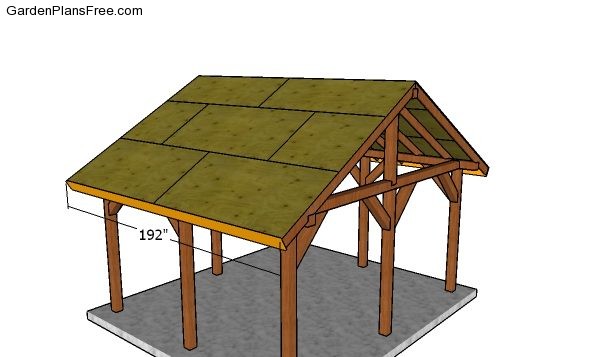
Side roof trims
Fit the 1×8 trims to the sides of the pavilion roof. Align the edges with attention and insert 2 1/2″ screws to lock them into place tightly.
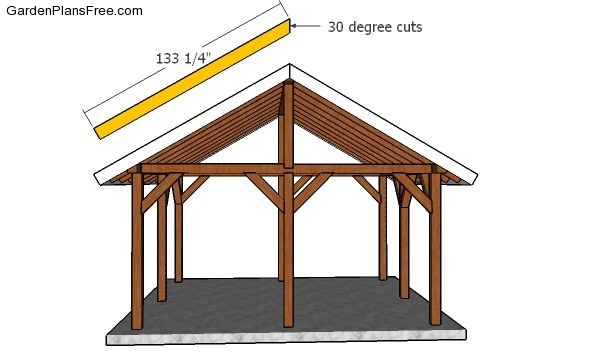
Front and back roof trims
Use 1×8 lumber for the front and back roof trims. Make a 30 degree cut at one end of the trims and then secure them into place with 2 1/2″ screws.
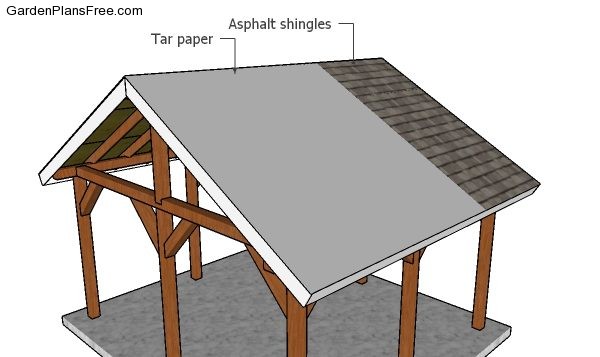
Fitting the roofing
In order to waterproof the pavilion, you have to cover the roofing sheets with felt. Make sure the strips of roofing felt overlap at least 2-3″ and staple them to the plywood sheets every 8″. Continue the project by installing the asphalt shingles. Place the starting course at the bottom of the roof, before fitting the rest of the shingles.
PRO TIP: Always read the manufacturer’s instructions, before installing the shingles. They provide essential information about the installation of the shingles.

14×16 Pavilion Plans – front view
Last but not least, you need to take care of the finishing touches. Fill the holes with wood putty and then smooth the surface with 120-220 grit sandpaper. You can add railings to the pavilion, if you want to make it look more like a gazebo. Free plans for a 16×20 gable pavilion, on the blog.
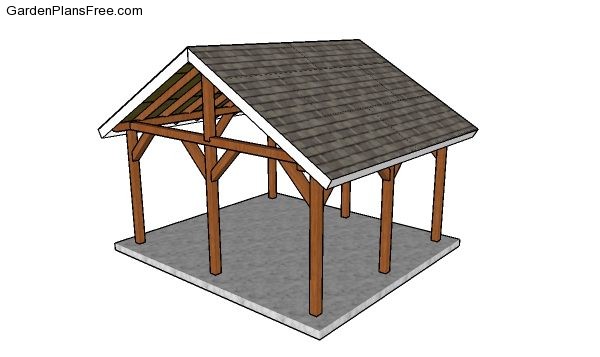
14×16 Pavilion Plans
Make sure you take a look over all my pergola plans HERE.
This diy project was about 14×16 pavilion plans. If you have enjoyed the free project, I recommend you to share it with your friends, by using the social media widgets. You can always save the plans as PDF or Print them using the floating widget on the left side of the screen (working only on PC or laptop).


11 comments
On the 14×16 Pavilion plans it calls for only 4 post anchors & there’s eight post. Can you please clarify? Thanks
You’re right, you need one anchor for each post. Sorry for the mistake.
How do you secure the posts that hold up the ridge beam?
Post to beam connectors. Like this: https://amzn.to/2VVknkW
I don’t find the link to download the PDF.
Please read the FAQs: https://gardenplansfree.com/faqs/
Where is the pdf download?
SEE this: https://gardenplansfree.com/faqs/
do u have plans for a 16×14 pavilon? its like this one but the roof peak the oppiste way>
would this design work, carry the load with 4X4s?
Es una excelente información para quienes nos gusta realizar casas de ese tipo.